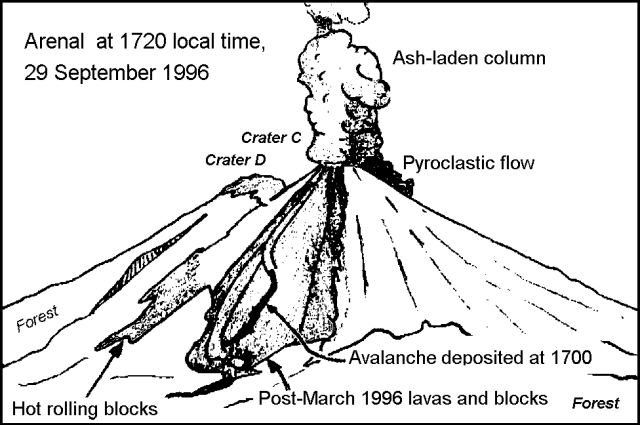Report on Arenal (Costa Rica) — September 1996
Bulletin of the Global Volcanism Network, vol. 21, no. 9 (September 1996)
Managing Editor: Richard Wunderman.
Arenal (Costa Rica) Small pyroclastic flows
Please cite this report as:
Global Volcanism Program, 1996. Report on Arenal (Costa Rica) (Wunderman, R., ed.). Bulletin of the Global Volcanism Network, 21:9. Smithsonian Institution. https://doi.org/10.5479/si.GVP.BGVN199609-345033
Arenal
Costa Rica
10.463°N, 84.703°W; summit elev. 1670 m
All times are local (unless otherwise noted)
Some small pyroclastic flows took place in September but eruptions were milder than the previous month. Eruptions were often separated by 10-60 minute intervals, and plumes seldom rose much over 1 km. During September, a new lava flow began moving toward the crater's SW side.
Noteworthy eruptions took place several times during September. An eruption at 0926 on the 11th generated a pyroclastic flow that traveled SW; the associated plume reached 1,230 m altitude. At 1700 on the 29th eyewitnesses saw a rockslide off a lava flow that led to a small avalanche (figure 80). Also, at 1720 that same day, an ash-column collapse produced a small pyroclastic flow (figure 80). At 1634 on the 30th a pyroclastic flow swept NW; the associated plume reached 1,000 m altitude.
During September, OVSICORI-UNA reported about average monthly seismic activity: 875 events and 300 hours of tremor (station VACR, 2.7 km NE of Crater C). ICE reported above-average seismic activity during September: 86 events and 4.78 hours of tremor (Fortuna Station, 3.5 km E of Crater C). OVSICORI-UNA noted that many of the seismic events were associated with Strombolian eruptions.
Although the volcano's distance network has generally shown a cumulative contraction since the initial measurements in 1991, a small pulse of inflation (reaching 5 ppm) took place in April 1996. Due to accumulating lava and pyroclastic materials, the summit of the active crater (C) grew 1.65 m between April and September 1996. This growth rate was consistent with the average rate of 4.13 m/year seen thus far in 1996 and close to the overall average of 5.33 m/year.
Arenal's post-1968 Strombolian-type eruptions have produced basaltic-andesite tephra and lavas. The volcano lies directly adjacent to Lake Arenal, a dammed reservoir for generating hydroelectric power.
Geological Summary. Conical Volcán Arenal is the youngest stratovolcano in Costa Rica and one of its most active. The 1670-m-high andesitic volcano towers above the eastern shores of Lake Arenal, which has been enlarged by a hydroelectric project. Arenal lies along a volcanic chain that has migrated to the NW from the late-Pleistocene Los Perdidos lava domes through the Pleistocene-to-Holocene Chato volcano, which contains a 500-m-wide, lake-filled summit crater. The earliest known eruptions of Arenal took place about 7000 years ago, and it was active concurrently with Cerro Chato until the activity of Chato ended about 3500 years ago. Growth of Arenal has been characterized by periodic major explosive eruptions at several-hundred-year intervals and periods of lava effusion that armor the cone. An eruptive period that began with a major explosive eruption in 1968 ended in December 2010; continuous explosive activity accompanied by slow lava effusion and the occasional emission of pyroclastic flows characterized the eruption from vents at the summit and on the upper western flank.
Information Contacts: E. Fernández, E. Duarte, V. Barboza, R. Van der Laat, E. Hernandez, M. Martinez, and R. Sáenz, Observatorio Vulcanológico y Sismológico de Costa Rica, Universidad Nacional (OVSICORI-UNA), Apartado 86-3000, Heredia, Costa Rica; G.J. Soto and J.F. Arias, Oficina de Sismología y Vulcanología del Arenal y Miravalles (OSIVAM), Instituto Costarricense de Electricidad (ICE), Apartado 10032-1000, San José, Costa Rica.


